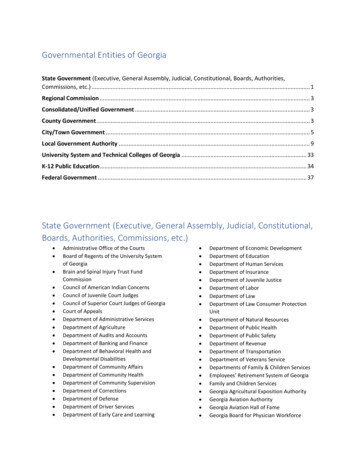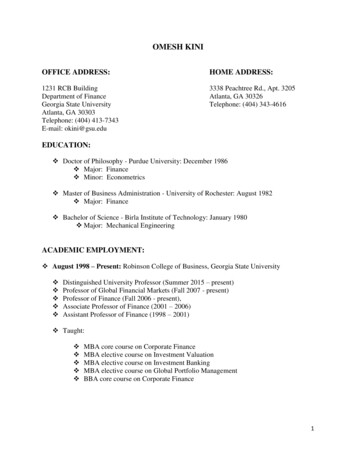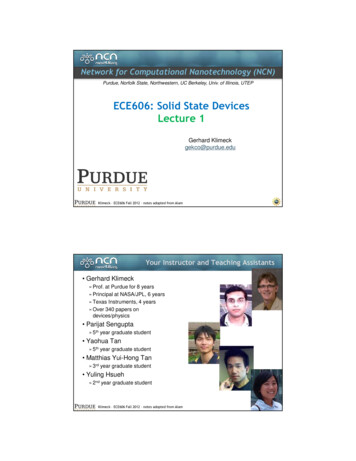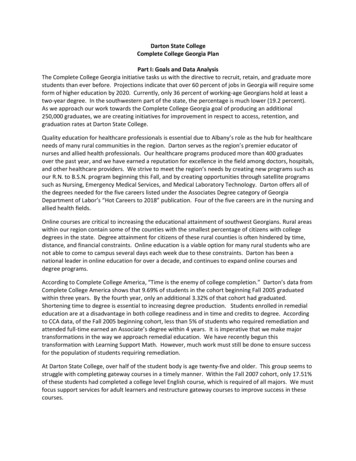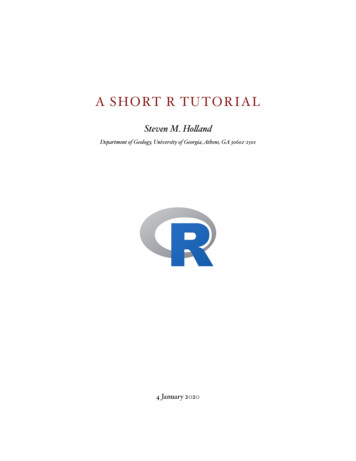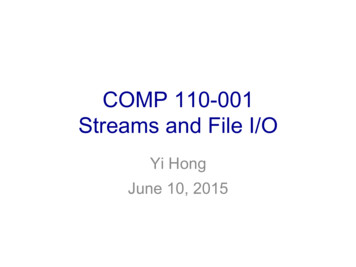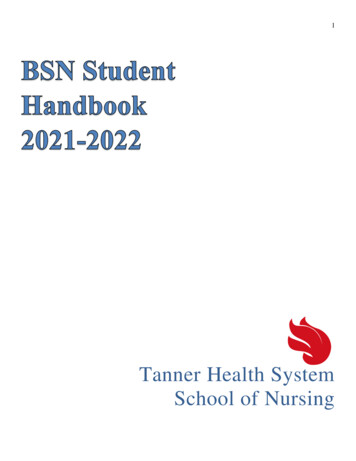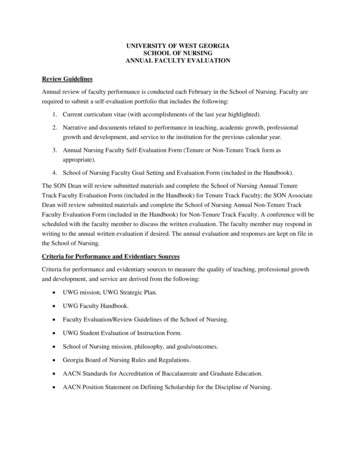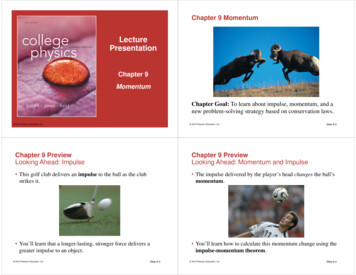
Transcription
Chapter 9 MomentumLecturePresentationChapter 9MomentumChapter Goal: To learn about impulse, momentum, and anew problem-solving strategy based on conservation laws. 2015 Pearson Education, Inc. 2015 Pearson Education, Inc.Slide 9-2Chapter 9 PreviewLooking Ahead: ImpulseChapter 9 PreviewLooking Ahead: Momentum and Impulse This golf club delivers an impulse to the ball as the clubstrikes it. The impulse delivered by the player’s head changes the ball’smomentum. You’ll learn that a longer-lasting, stronger force delivers agreater impulse to an object. You’ll learn how to calculate this momentum change using theimpulse-momentum theorem. 2015 Pearson Education, Inc.Slide 9-3 2015 Pearson Education, Inc.Slide 9-4
Chapter 9 PreviewLooking Ahead: Conservation of MomentumChapter 9 PreviewLooking Ahead The momentum of these pool balls before and after they collideis the same—it is conserved.Text: p. 254 You’ll learn a powerful new before-and-after problem-solvingstrategy using this law of conservation of momentum. 2015 Pearson Education, Inc.Slide 9-5 2015 Pearson Education, Inc.Chapter 9 PreviewLooking Back: Newton’s Third LawChapter 9 PreviewStop to Think In Section 4.7, you learned aboutNewton’s third law. In this chapter,you’ll apply this law in order tounderstand the conservation ofmomentum.A hammer hits a nail. The force ofthe nail on the hammer isA. Greater than the force of thehammer on the nail.B. Less than the force of thehammer on the nail.C. Equal to the force of the hammeron the nail.D. Zero. Newton’s third law states that theforce that object B exerts on A hasequal magnitude but is directedopposite to the force that A exertson B. 2015 Pearson Education, Inc.Slide 9-6Slide 9-7 2015 Pearson Education, Inc.Slide 9-8
Reading Question 9.1Reading Question 9.1Impulse isImpulse isA. A force that is applied at a random time.B. A force that is applied very suddenly.C. The area under the force curve in a force-versus-timegraph.D. The time interval that a force lasts. 2015 Pearson Education, Inc.Slide 9-9A. A force that is applied at a random time.B. A force that is applied very suddenly.C. The area under the force curve in a force-versus-timegraph.D. The time interval that a force lasts. 2015 Pearson Education, Inc.Reading Question 9.2Reading Question 9.2In the impulse approximation,In the impulse approximation,A. A large force acts for a very short time.B. The true impulse is approximated by a rectangular pulse.C. No external forces act during the time the impulsive forceacts.D. The forces between colliding objects can be neglected. 2015 Pearson Education, Inc.Slide 9-11Slide 9-10A. A large force acts for a very short time.B. The true impulse is approximated by a rectangular pulse.C. No external forces act during the time the impulsive forceacts.D. The forces between colliding objects can be neglected. 2015 Pearson Education, Inc.Slide 9-12
Reading Question 9.3Reading Question 9.3The total momentum of a system is conservedThe total momentum of a system is conservedA.B.C.D.Always.If no external forces act on the system.If no internal forces act on the system.Never; it’s just an approximation. 2015 Pearson Education, Inc.A.B.C.D.Slide 9-13Always.If no external forces act on the system.If no internal forces act on the system.Never; it’s just an approximation. 2015 Pearson Education, Inc.Reading Question 9.4Reading Question 9.4In an inelastic collision,In an inelastic collision,A.B.C.D.E.Impulse is conserved.Momentum is conserved.Force is conserved.Energy is conserved.Elasticity is conserved. 2015 Pearson Education, Inc.A.B.C.D.E.Slide 9-15Slide 9-14Impulse is conserved.Momentum is conserved.Force is conserved.Energy is conserved.Elasticity is conserved. 2015 Pearson Education, Inc.Slide 9-16
Reading Question 9.5Reading Question 9.5An object’s angular momentum is proportional to itsAn object’s angular momentum is proportional to itsA.B.C.D.Mass.Moment of inertia.Kinetic energy.Linear momentum.A.B.C.D.Slide 9-17 2015 Pearson Education, Inc.Mass.Moment of inertia.Kinetic energy.Linear momentum. 2015 Pearson Education, Inc.Slide 9-18Impulse A collision is a short-duration interaction between twoobjects.Section 9.1 Impulse During a collision, it takes time to compress the object,and it takes time for the object to re-expand. The duration of a collision depends on the materials. 2015 Pearson Education, Inc. 2015 Pearson Education, Inc.Slide 9-20
ImpulseImpulse When kicking a soccerball, the amount by whichthe ball is compressed is ameasure of the magnitudeof the force the foot exertson the ball. The effect of an impulsiveforce is proportional tothe area under theforce-versus-time curve. The area is called theimpulse J of the force. The force is applied onlywhile the ball is in contactwith the foot. The impulse force is a largeforce exerted during a shortinterval of time. 2015 Pearson Education, Inc.Slide 9-21 2015 Pearson Education, Inc.Slide 9-22QuickCheck 9.6QuickCheck 9.6Two 1.0 kg stationary cue balls are struck by cue sticks. Thecues exert the forces shown. Which ball has the greater finalspeed?Two 1.0 kg stationary cue balls are struck by cue sticks. Thecues exert the forces shown. Which ball has the greater finalspeed?A. Ball 1B. Ball 2C. Both balls have the same final speed. 2015 Pearson Education, Inc.A. Ball 1B. Ball 2C. Both balls have the same final speed.Slide 9-23 2015 Pearson Education, Inc.Slide 9-24
ImpulseImpulse It is useful to think of thecollision in terms of anaverage force Favg. Impulse has units of N s, but N s are equivalent tokg m/s. Favg is defined as the constantforce that has the sameduration t and the samearea under the force curveas the real force. 2015 Pearson Education, Inc. The latter are the preferred units for impulse. The impulse is a vector quantity, pointing in the directionof the average force vector:Slide 9-25 2015 Pearson Education, Inc.Slide 9-26Example 9.1 Finding the impulse on a bouncingballExample 9.1 Finding the impulse on a bouncingball (cont.)A rubber ball experiences theforce shown in FIGURE 9.4as it bounces off the floor.PREPARE Theimpulse is thearea under the force curve.Here the shape of the graphis triangular, so we’ll needto use the fact that the areaof a triangle is height base.a. What is the impulse on theball?b. What is the average forceon the ball? 2015 Pearson Education, Inc.Slide 9-27 2015 Pearson Education, Inc.Slide 9-28
Example 9.1 Finding the impulse on a bouncingball (cont.)SOLVEa. The impulse isIn this particularexample, the average valueof the force is half themaximum value. This is notsurprising for a triangularforce because the area of atriangle is half the basetimes the height.ASSESSb. From Equation 9.1,J Favg t, we can findthe average force thatwould give this same impulse: 2015 Pearson Education, Inc.Example 9.1 Finding the impulse on a bouncingball (cont.)Slide 9-29 2015 Pearson Education, Inc.Slide 9-30Momentum and the Impulse-MomentumTheoremSection 9.2 Momentum andthe Impulse-Momentum Theorem Intuitively we know thatgiving a kick to a heavyobject will change itsvelocity much less thangiving the same kick to alight object. We can calculate how thefinal velocity is related tothe initial velocity. 2015 Pearson Education, Inc. 2015 Pearson Education, Inc.Slide 9-32
Momentum and the Impulse-MomentumTheoremMomentum and the Impulse-MomentumTheorem From Newton’s second law, the average acceleration of anobject during the time the force is being applied is We can rearrange that equation in terms of impulse: The average acceleration is related to the change in thevelocity by Momentum is the product of the object’s mass andvelocity. It has units of kg m/s. We combine those two equations to find 2015 Pearson Education, Inc.Slide 9-33Momentum and the Impulse-MomentumTheorem 2015 Pearson Education, Inc.Slide 9-34Momentum and the Impulse-MomentumTheorem Momentum is a vector quantitythat points in the same directionas the velocity vector: The magnitude of an object’smomentum is simply theproduct of the object’s massand speed. 2015 Pearson Education, Inc.Slide 9-35 2015 Pearson Education, Inc.Slide 9-36
The Impulse-Momentum TheoremThe Impulse-Momentum Theorem Impulse and momentum are related as: The impulse-momentum theorem states that animpulse delivered to an object causes the object’smomentum to change. Impulse can be written in terms of its x- and ycomponents: 2015 Pearson Education, Inc.Slide 9-37Slide 9-38 2015 Pearson Education, Inc.QuickCheck 9.2QuickCheck 9.2A 2.0 kg object moving to the right with speed 0.50 m/sexperiences the force shown. What are the object’s speedand direction after the force ends?A 2.0 kg object moving to the right with speed 0.50 m/sexperiences the force shown. What are the object’s speedand direction after the force ends?A.B.C.D.E.0.50 m/s leftAt rest0.50 m/s right1.0 m/s right2.0 m/s rightA.B.C.D.E.0.50 m/s leftAt rest0.50 m/s right1.0 m/s right2.0 m/s right px Jx or pfx pix Jx 2015 Pearson Education, Inc.Slide 9-39 2015 Pearson Education, Inc.Slide 9-40
QuickCheck 9.4QuickCheck 9.4A force pushes the cart for 1 s, starting from rest. To achievethe same speed with a force half as big, the force wouldneed to push forA force pushes the cart for 1 s, starting from rest. To achievethe same speed with a force half as big, the force wouldneed to push for11A. 4 sB. 12 sC. 1 sD. 2 sE. 4 s 2015 Pearson Education, Inc.A. 4 sB. 12 sC. 1 sD. 2 sE. 4 sSlide 9-41 2015 Pearson Education, Inc.Example 9.2 Calculating the change inmomentumExample 9.2 Calculating the change inmomentum (cont.)A ball of mass m 0.25 kgrolling to the right at 1.3 m/sstrikes a wall and reboundsto the left at 1.1 m/s. Whatis the change in the ball’smomentum? What is theimpulse delivered to it bythe wall?PREPARE A visual 2015 Pearson Education, Inc.Slide 9-42overview of[Insert Figure 9.8 (repeated)]the ball bouncing is shown inFIGURE 9.8. This is a new kindof visual overview, one in whichwe show the situation “before”and “after” the interaction. We’llhave more to say about beforeand-after pictures in the nextsection. The ball is moving alongthe x-axis, so we’ll write the momentum in component form, as inEquation 9.7. The change in momentum is then the difference betweenthe final and initial values of the momentum. By the impulsemomentum theorem, the impulse is equal to this change inmomentum.Slide 9-43 2015 Pearson Education, Inc.Slide 9-44
Example 9.2 Calculating the change inmomentum (cont.)Example 9.2 Calculating the change inmomentum (cont.)SOLVE TheIt is particularly important[Insert Figure 9.8 (repeated)]to notice that the x-componentof the momentum, like thatof the velocity, is negative.This indicates that the ballis moving to the left. Thechange in momentum isx-componentof the initial momentum is[Insert Figure 9.8 (repeated)]The y-component of themomentum is zero bothbefore and after the bounce.After the ball rebounds,the x-component is 2015 Pearson Education, Inc.Slide 9-45Example 9.2 Calculating the change inmomentum (cont.)Slide 9-46The Impulse-Momentum Theorem The impulse-momentum theorem tells usBy the impulse-momentumtheorem, the impulsedelivered to the ball bythe wall is equal to thischange, so The average force needed to stop an object is inverselyproportional to the duration of the collision.ASSESS Theimpulse is negative,indicating that the force causing the impulse is pointing tothe left, which makes sense. 2015 Pearson Education, Inc. 2015 Pearson Education, Inc.Slide 9-47 If the duration of the collision can be increased, theforce of the impact will be decreased. 2015 Pearson Education, Inc.Slide 9-48
The Impulse-Momentum TheoremExample ProblemA 0.5 kg hockey puck slides to the right at 10 m/s. It is hitwith a hockey stick that exerts the force shown. What is itsapproximate final speed? The spines of a hedgehog obviously help protect it frompredators. But they serve another function as well. If a hedgehogfalls from a tree—a not uncommon occurrence—it simply rollsitself into a ball before it lands. Its thick spines then cushion theblow by increasing the time it takes for the animal to come torest. Indeed, hedgehogs have been observed to fall out of trees onpurpose to get to the ground! 2015 Pearson Education, Inc.Slide 9-49 2015 Pearson Education, Inc.Slide 9-50QuickCheck 9.5QuickCheck 9.5A light plastic cart and a heavy steel cart are both pushedwith the same force for 1.0 s, starting from rest. After theforce is removed, themomentum of the lightplastic cart is thatof the heavy steel cart.A light plastic cart and a heavy steel cart are both pushedwith the same force for 1.0 s, starting from rest. After theforce is removed, themomentum of the lightplastic cart is thatof the heavy steel cart.A.B.C.D.Greater thanEqual toLess thanCan’t say. It depends on how big the force is. 2015 Pearson Education, Inc.A.B.C.D.Slide 9-51Greater thanSame force, same time same impulseEqual toSameimpulse same change of momentumLess thanCan’t say. It depends on how big the force is. 2015 Pearson Education, Inc.Slide 9-52
Try It Yourself: Water Balloon CatchThe Impulse-Momentum TheoremIf you’ve ever tried to catch a water balloon, you may havelearned the hard way not to catch it with your arms rigidlyextended. The brief collision time implies a large, balloonbursting force. A better way to catch a water balloon is topull your arms in toward your body as you catch it,lengthening the collision time and hence reducing the forceon the balloon.Text: p. 259 2015 Pearson Education, Inc.Slide 9-53 2015 Pearson Education, Inc.Total Momentum If there is a system of particlesmoving, then the system as awhole has an overall momentum. The total momentum of a systemof particles is the vector sum ofthe momenta of the individualparticles: 2015 Pearson Education, Inc.Section 9.3 Solving Impulse andMomentum ProblemsSli
Slide 9-9 Reading Question 9.1 Impulse is A. A force that is applied at a random time. B. A force that is applied very suddenly. C. The area under the force curve in a force-versus-time
